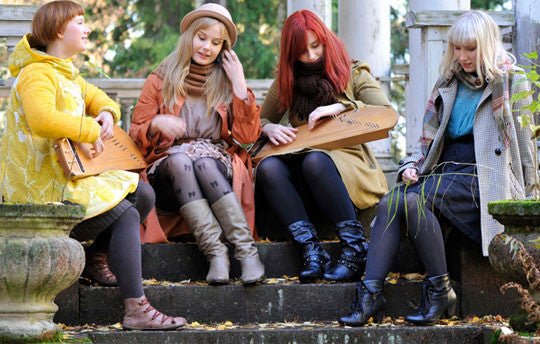Your Cart is Empty

Finnish music is at heart a subtle creature of quiet places or small gatherings and is best understood in situ.
Until the seventeenth century virtually all Finnish singing was of the runolaulu (runo-song) form. The tunes have a narrow range, usually using just the first five notes of a scale, a time signature of 4/4 or 5/4, and alliterative line-ends.
Among runo-songthere’s a large body of epic poetry and tales. It was these epics that doctor and folklorist Elias Lönnrot linked and organised to make the Kalevala – a publication that would later become iconic in the emerging national identity and awakening of Finnishness.
Runolaulu’s melodic, rhythmic and lyrical forms are dominant in the material of Sanna Kurki-Suonio – an increasingly important force in Finnish roots music.
During the seventeenth century rhyming in songs began to take over from alliteration, and runolaulu evolved into rekilaulu(sleigh song). With its very regular pattern reki-song is common in popular Finnish songs, encouraging audience participation through its familiar structure.
The old instruments of Finnish music include various wind instruments; among them horns, whistles and folk clarinets made out of wood bound with birch-bark. The kantele and jouhikko are the two principal Finnish stringed instruments – kantele, Finland’s national instrument is a form of zither; and the jouhikko is a bowed lyre.
Pelimanni, meaning ‘folk musician’, is a term applied to players of folk dance music. Pelimanni music and its dances are a much more recent development than the runo-song, and are traditionally lead by the fiddle (viulu), accordion (haitari) or harmonium (hannoni).
Inevitably, in talking about pelimanni music and current Finnish roots music, the name Kaustinen comes up regularly.
The 1960s was a boom time for roots-discovery and in 1968 Kaustinen staged its first International Folk Festival, giving focus for celebration of the old ways and the old fun. The festival site later went on to become the headquarters of Kansanmusiikki-instituutti (KMI), the national Folk Music Institute – providing a leading role not only in research but also in encouragement and propagation of roots music.
JPP are a group of Finnish folk musicians, mainly fiddlers, originating from Kaustinen. They employ a traditional pelimanni style although their arrangements are more advanced than their predecessors.
Some involvement with live music is central to Kaustinen’s social life. Active local groups include Purppirpelimannit, the wedding choir Hääkuroro, the youth dance group Ottoset and a string of brashly energetic popish bands – Folkkarit, Prusikoukku Soundmachine and Viitalan Perlimannit.
Kaustinen is still Finland’s largest folk festival, but there’s increasing choice. The festival Haapavesi has a growing reputation; as does the Kihaus festival at the village of Rääkylä, centre of the Värttinä sound.
Värttinä, with its exuberant female vocal line-up and traditional songs, quickly became popular at home, as well as the best-known Finnish roots band abroad.
A strong contributing factor to the new wave in Finland is the dynamic involvement of research institutions, particularly the Kaustinen-based KMI and music colleges such as Sibelius Academy. Sibelius’ folk department is a creative place, full of technology, in which to carry through aims of “learning the old styles of playing and to break through all perceived limits to create the folk music of the future.” Many of the leading names in roots music are to be found there, either as students or teachers. For example some members of the up and coming band Kardemimmit currently study at the Sibelius Academy.
Kardemimmit with their angelic soft vocals and dextrous touch on the strings bring the kantele, a traditional zither, to life on their innovative World Music Network album Introducing Kardemimmit.
The quartet performs modern folk music, intertwining the songs of old with their own fresh compositions. They explore roots styles including reki-style singing, Perhonjoki valley style, and runo-song, and infuse the music with a new, quirky edge.
Maija, Jutta, Anna and Leeni met studying at a music school, and have played together ever since. Their seamless musicianship is testament to their ten years of collaboration. The talented ensemble has performed throughout Scandinavia and the USA. Introducing Kardemimmit is their first international release, and is set to spread their unique, folky brand further afield.
Parts of west-coast Finland, and the islands Ahvenanmaa and the Turku archipelago, are mainly Swedish in language and culture. There are a number of Swedish-style spelman groups and, in Vaasa, a folk music research institute named Svenska Folkmusikinstitutet, teaming up with Swedish record labels. Conversely, in the north of Sweden are many Finnish-speakers and recognisisably Finnish music such as Norrlåtarand JP Nyströms.
Vaasa-based Gjallarhorn focuses on this Finnish-Swedish material.
A highly significant group, both culturally and musically, are the Sàmi – their territory running across northern parts of Norway, Sweden, Finland and Russia. Sàmi musicians with Finnish connections include Wimme Saari, Angelin tytöt,Nils-Aslak Valkeapää and Ulla Pirttijärvi.
Gypsy singing has been an important influence on many of the emerging generation of Finnish revival singers.
The warm, but sad-sounding delivery sometimes comes close to that of the older Finnish tango singers, amongst whom Gypsies have often figured.
Tango – which reached Finland in the 1920s, has made its way into Finnish tradition to become part of the standard repertoire of pelimanni bands. Tangomarkkinat is the world’s oldest tango festival and is held at Seinäjoki in Finland.
Piirpauke, the folk-world-jazz fusion band has been a pioneer in crossing world influences with Finnish traditional music. Other bands using, or inspired by other cultures, include Galaxy and Slobo Horo – there’s even a Helsinki Scottish pipe band!